
This site examines the events of the Hungarian Revolution. It includes a timeline and glossary of events, people, and groups, and other organizations.
- Subject:
- Social Studies
- Material Type:
- Reading
- Date Added:
- 12/01/2023

This site examines the events of the Hungarian Revolution. It includes a timeline and glossary of events, people, and groups, and other organizations.

This site from the Fordham University provides a great alternative perspective of the Baghdad Pact and the Central Treaty Organization. This is a statement given by the USSR Ministry of Foreign Affairs on Security in the Near and Middle East in 1955. He sees US domination rather than military security as the prime motive of the plan. An interesting piece from which to balance history.
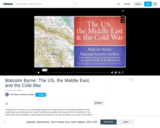
Professor Malcolm Byrne of George Washington University discusses the policies of the United States overseas, the balance between idealism and reality, and why those in the Middle East do not like Americans. Byrne explains the importance of understanding what is happening currently the history of that region must be understood. [1:10:46]

This resource has an incredible amount of information regarding propaganda. Includes links to numerous topics with propaganda analysis. Offers unique perspectives that challenge the reader to question commonly held beliefs.

Learn about the Cold War, a period of geopolitical tension between the United States and the Soviet Union and their respective allies, the Western Bloc and the Eastern Bloc, which began following World War II.

These videos and support materials explore the intense division experienced by those who testified before and blacklisted by HUAC during the Cold War, focusing on the testimony of Elia Kazan. The videos are from American Masters None Without Sin. Using video, text, and text-dependent discussion questions, students will better understand the public investigation in allegations of Communist activity in the US during the early years of the Cold War.

This primary document is a copy of the Helsinki Agreements of 1975 which recognized the borders in central and Eastern Europe that were set up since the end of WWII. They show the acceptance of the Soviet influence in Eastern Europe. and called for protection of the human rights for all citizens of the nations signing the agreement.
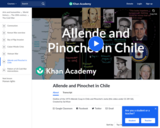
In this 15-minute video lesson Sal gives an outline of the 1973 Allende Coup in Chile and Pinochet's Junta. [History playlist: Lesson 11 of 26]
Khan Academy learning modules include a Community space where users can ask questions and seek help from community members. Educators should consult with their Technology administrators to determine the use of Khan Academy learning modules in their classroom. Please review materials from external sites before sharing with students.
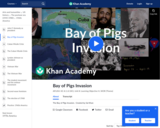
This 14-minute video lesson discusses the Bay of Pigs Invasion. [History playlist: Lesson 7 of 26]
Khan Academy learning modules include a Community space where users can ask questions and seek help from community members. Educators should consult with their Technology administrators to determine the use of Khan Academy learning modules in their classroom. Please review materials from external sites before sharing with students.
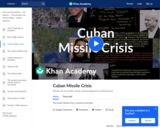
This 19-minute video lesson provides an overview of the Cuban Missel Crisis. [History playlist: Lesson 8 of 26]
Khan Academy learning modules include a Community space where users can ask questions and seek help from community members. Educators should consult with their Technology administrators to determine the use of Khan Academy learning modules in their classroom. Please review materials from external sites before sharing with students.
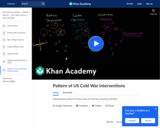
In this 9-minute video lesson, Sal compares the pattern of U.S. Cold War interventions in Korea, Cuba, and Vietnam. [History playlist: Lesson 10 of 26]
Khan Academy learning modules include a Community space where users can ask questions and seek help from community members. Educators should consult with their Technology administrators to determine the use of Khan Academy learning modules in their classroom. Please review materials from external sites before sharing with students.
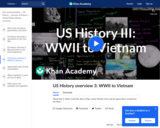
This 15-minute video lesson gives a basic overview of U.S. history from World War II to the Vietnam War. It briefly looks at Hitler, the Cold War, the Bay of Pigs, the Cuban Missile Crisis, and the Space Race. [History playlist: Lesson 4 of 26]
Khan Academy learning modules include a Community space where users can ask questions and seek help from community members. Educators should consult with their Technology administrators to determine the use of Khan Academy learning modules in their classroom. Please review materials from external sites before sharing with students.
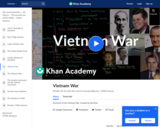
This 18-minute video lesson provides an overview of the Vietnam War. [History playlist: Lesson 9 of 26]
Khan Academy learning modules include a Community space where users can ask questions and seek help from community members. Educators should consult with their Technology administrators to determine the use of Khan Academy learning modules in their classroom. Please review materials from external sites before sharing with students.

Here one finds President Johnson's address to the nation in which he lays out his legislative priorities and his assessment of foreign affairs the early part of his administration.
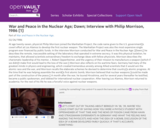
At age twenty-seven, physicist Philip Morrison joined the Manhattan Project, the code name given to the U.S. government's covert effort at Los Alamos to develop the first nuclear weapon. The Manhattan Project was also the most expensive single program ever financed by public funds. In this video segment, Morrison describes the charismatic leadership of his mentor, J. Robert Oppenheimer, and the urgency of their mission to manufacture a weapon 'which if we didn't make first would lead to the loss of the war." In the interview Morrison conducted for War and Peace in the Nuclear Age: 'Dawn,' he describes the remote, inaccessible setting of the laboratory that operated in extreme secrecy. It was this physical isolation, he maintains, that allowed scientists extraordinary freedom to exchange ideas with fellow physicists. Morrison also reflects on his wartime fears. Germany had many of the greatest minds in physics and engineering, which created tremendous anxiety among Allied scientists that it would win the atomic race and the war, and Morrison recalls the elaborate schemes he devised to determine that country's atomic progress. At the time that he was helping assemble the world's first atomic bomb, Morrison believed that nuclear weapons 'could be made part of the construction of the peace.' A month after the war, he toured Hiroshima, and for several years thereafter he testified, became a public spokesman, and lobbied for international nuclear cooperation. After leaving Los Alamos, Morrison returned to academia. For the rest of his life he was a forceful voice against nuclear weapons.

This site discusses the United States' struggle to halt the spread of Communism at the height of the Cold War.
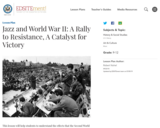
Learn about the effects that the Second World War had on jazz music as well as the contributions that jazz musicians made to the war effort. This lesson will help students explore the role of jazz in American society and the ways that jazz functioned as an export of American culture and a means of resistance to the Nazis.

An audio recording of a speech given to Americans by John F. Kennedy on October 22, 1962 where he talks about the buildup of Soviet military power in Cuba. A transcript is also provided. [17:37]
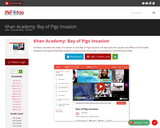
Sal Khan narrates this video of a lesson on the Bay of Pigs Invasion. He discusses the causes and effects of this failed endeavor during the Kennedy invasion using pictures and maps to illustrate his commentary.[13:42]
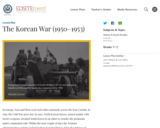
In 1950, North Korean forces, armed mainly with Soviet weapons, invaded South Korea in an effort to reunite the peninsula under communist rule. This lesson will introduce students to the conflict by having them read the most important administration documents related to it.